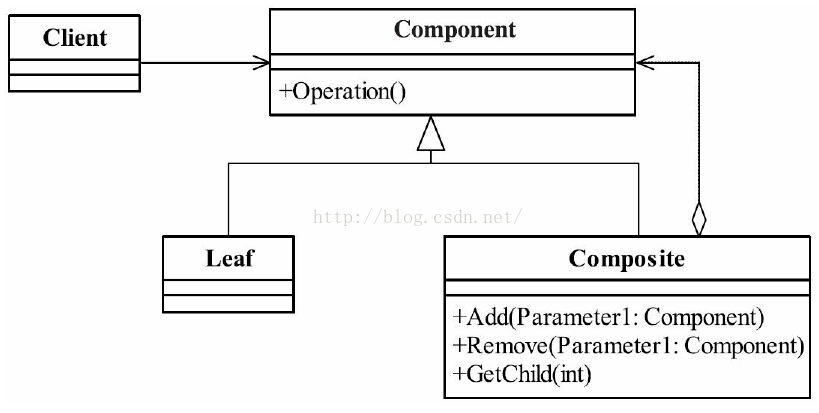一.定义
组合模式(Component)也叫合成模式,有时又叫做部分-整体模式,主要是用来描述部分与整体的关系。将对象组合成树形结构以表示“部分-整体”的层次结构,使得用户对单个对象和组合对象的使用具有一致性。
二、模式结构成员构成

• Component 抽象构件角色
定义参加组合对象的共有方法和属性,可以定义一些默认的行为或属性。
• Leaf 叶子构件
叶子对象,其下再也没有其他的分支,也就是遍历的最小单位。
• Composite 树枝构件
树枝对象,它的作用是组合树枝节点和叶子节点形成一个树形结构。

三.代码示例

1 /** 2 * Component 3 * 抽象构件 4 */ 5 public abstract class Component { 6 //个体和整体都具有的共享 7 public void doSomething() { 8 //编写业务逻辑 9 } 10 } 11 12 /** 13 * Composite 14 * 树枝构件 15 */ 16 public class Composite extends Component { 17 //构件容器 18 private ArrayList<Component> componentArrayList = new ArrayList<Component>(); 19 20 //增加一个叶子构件或树枝构件 21 public void add(Component component) { 22 this.componentArrayList.add(component); 23 } 24 25 //删除一个叶子构件或树枝构件 26 public void remove(Component component) { 27 this.componentArrayList.remove(component); 28 } 29 30 //获得分支下的所有叶子构件和树枝构件 31 public ArrayList<Component> getChildren() { 32 return this.componentArrayList; 33 } 34 } 35 36 /** 37 * Leaf 38 * 树叶构件 39 * 树叶节点是没有子下级对象的对象,定义参加组合的原始对象行为。 40 */ 41 public class Leaf extends Component { 42 43 // 可以覆写父类方法 44 @Override 45 public void doSomething() { 46 47 } 48 } 49 50 /** 51 * Client 52 * 测试类负责树状结构的建立,并可以通过递归方式遍历整个树。 53 */ 54 public class Client { 55 public static void main(String[] args) { 56 //创建一个根节点 57 Composite root = new Composite(); 58 root.doSomething(); 59 //创建一个树枝构件 60 Composite branch = new Composite(); 61 //创建一个叶子节点 62 Leaf leaf = new Leaf(); 63 //建立整体 64 root.add(branch); 65 branch.add(leaf); 66 } 67 68 //通过递归遍历树 69 public static void display(Composite root) { 70 for (Component c : root.getChildren()) { 71 if (c instanceof Leaf) { //叶子节点 72 c.doSomething(); 73 } else { //树枝节点 74 display((Composite) c); 75 } 76 } 77 } 78 }
四.优点和缺点分析
优点:
>对于客户端来说,简化了调用,对于树形结构中的所有节点都是Component,局部和整体对调用者来说没有任何区别,高层模块不必关心自己处理的是单个对象还是整个组合结构,简化了高层模块的代码。
>使用了组合模式,增加一个树枝节点、树叶节点很容易,只要找到它的父节点就成,非常容易扩展,符合开闭原则
缺点:
>组合模式有一个非常明显的缺点,直接使用了实现类!这在面向接口编程上是很不恰当的,与依赖倒置原则冲突,它限制了你接口的影响范围。
五.应用场景
> 维护和展示部分-整体关系的场景,如树形菜单、文件和文件夹管理。
> 从一个整体中能够独立出部分模块或功能的场景。
> 从一个整体中能够独立出部分模块或功能的场景。
